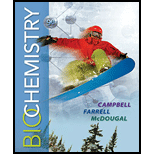
Concept explainers
Interpretation:
The chemicals or enzymes that are used for cutting proteins into fragments and would be least useful for i are to be identified.
Concept introduction:
Before the sequencing experiment of proteins takes place, the peptides are converted into small length peptides by the action of certain chemicals or enzymes that cut the proteins at specific points to yield smaller fragments of peptides. Examples of such chemicals or enzymes are: trypsin, chymotrypsin, and cyanogen bromide.
The reagent cyanogen bromide cleaves the protein peptides at their internal residues of methionine.
The proteolytic enzyme trypsin cleaves the protein peptides at the sites where basic amino acid (histidine, lysine, and arginine) residues are present. But, as histidine is neutral in nature, trypsin does not react with it.
The proteolytic enzyme chymotrypsin cleaves the protein peptides at the sites where the
Want to see the full answer?
Check out a sample textbook solution
Chapter 5 Solutions
Biochemistry
- REFLECT AND APPLY Explain why a 50S ribosomal subunit and a 30S ribosomal subunit combine to form a 70S subunit, instead of an 80S subunit.arrow_forwardREFLECT AND APPLY Common proteins are polymers of 20 different amino acids. How big a protein (how many amino acid residues) would be necessary to have an Avogadros number of possible sequences?arrow_forwardREFLECT AND APPLY You are in the process of determining the amino acid sequence of a peptide. After trypsin digestion followed by the Edman degradation, you see the following peptide fragments: LeuGlyArgGlySerPheTyrAsnHisSerGluAspMetCysLysThrTyrGluValCysMetHis What is abnormal concerning these results? What might have been the problem that caused it?arrow_forward
- REFLECT AND APPLY A sample of a peptide of unknown sequence was treated with trypsin; another sample of the same peptide was treated with chymotrypsin. The sequences (N-terminal to C-terminal) of the smaller peptides produced by trypsin digestion were as follows: MetValSerThrLysValIleTrpThrLeuMetIleLeuPheAsnGluSeArg The sequences of the smaller peptides produced by chymotrypsin digestion were as follows: AsnGluSerArgValIleTrpThrLeuMetIleMetValSerThrLysLeuPhe Deduce the sequence of the original peptide.arrow_forwardREFLECT AND APPLY A friend tells you that only four different kinds of bases are found in RNA. What would you say in reply?arrow_forwardREFLECT AND APPLY You are in the process of determining the amino acid sequence of a protein and must reconcile contradictory results. In one trial, you determine a sequence with glycine as the N-terminal amino acid and asparagine as the C-terminal amino acid. In another trial, your results indicate phenylalanine as the N-terminal amino acid and alanine as the C-terminal amino acid. How do you reconcile this apparent contradiction?arrow_forward
- REFLECT AND APPLY A sample of an unknown peptide was divided into two aliquots. One aliquot was treated with trypsin; the other was treated with cyanogen bromide. Given the following sequences (N-terminal to C-terminal) of the resulting fragments, deduce the sequence of the original peptide. Trypsin treatment AsnThrTrpMetIleLysGlyTyrMetGlnPheValLeuGlyMetSerArg Cyanogen bromide treatment GlnPheValLeuGlyMetIleLysGlyTyrMetSerArgAsnThrTrpMetarrow_forwardREFLECT AND APPLY Glycine is a highly conserved amino acid residue in proteins (i.e., it is found in the same position in the primary structure of related proteins). Suggest a reason why this might occur.arrow_forwardREFLECT AND APPLY The fidelity of protein synthesis is assured twice during protein synthesis. How and when?arrow_forward
- REFLECT AND APPLY List three molecular changes that take place in the processing of eukaryotic mRNA.arrow_forwardREFLECT AND APPLY The enzyme D-amino acid oxidase has a very high turnover number because the D-amino acids are potentially toxic. The KM for the enzyme is in the range of 1 to 2 mM for the aromatic amino acids and in the range of 15 to 20 mM for such amino acids as serine, alanine, and the acidic amino acids. Which of these amino acids are the preferred substrates for the enzyme?arrow_forwardREFLECT AND APPLY What is the energy cost per amino acid in prokaryotic protein synthesis? Relate this to low entropy.arrow_forward
 BiochemistryBiochemistryISBN:9781305961135Author:Mary K. Campbell, Shawn O. Farrell, Owen M. McDougalPublisher:Cengage Learning
BiochemistryBiochemistryISBN:9781305961135Author:Mary K. Campbell, Shawn O. Farrell, Owen M. McDougalPublisher:Cengage Learning
